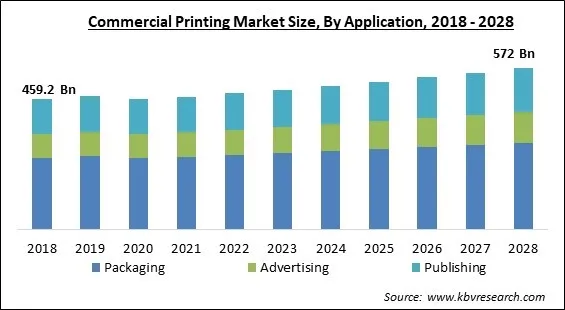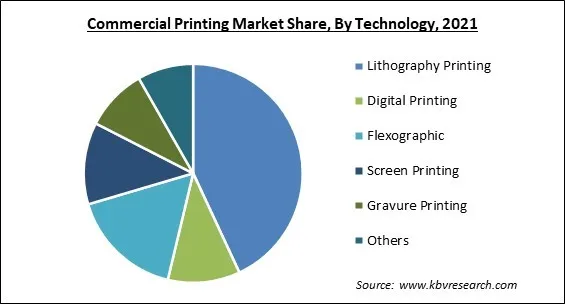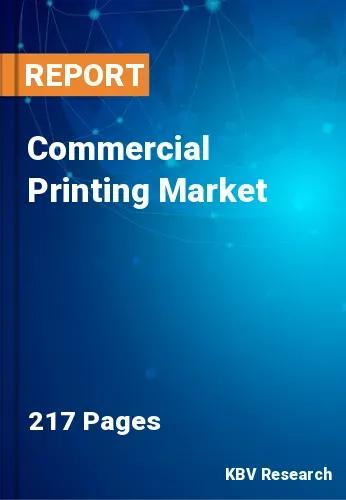The Global Commercial Printing Market size is expected to reach $572 billion by 2028, rising at a market growth of 2.9% CAGR during the forecast period.
Commercial printing is a cluster of connected services that includes press productions, binding, composition, and bulk printing. Commercial printers publish and print magazines, catalogs, business forms, training manuals, phone books, and other printing materials. Printers include a paper input, ink changer, analog or digital control panel, fold-out tray, and a paper output tray. It has a broad range of applications in publishing and printing houses and a massive organization that utilizes services to manage operations smoothly.

Commercial printing is also called commercial as the procedure mainly consists of massive volumes of items. However, organizations use these printed items for commercial usages such as marketing, publishing, advertising, and retail which help them to develop a brand image and an excellent vague idea of their audience. In addition, commercial printing helps in saving time which allows companies to concentrate on other essential tasks.
The offset printing procedure leverages wet ink and printing plates to create materials. The printing plate contains the content or article consumers wish to print on. After that, the printing machine prints the image and switch to a rubber blanket before the final stage of the printing surface. While working in commercial printing, the technician has enhanced control over the technique and the colors. Offset lithography ensures high-quality printing with high resolution and better image quality prints.
Offset lithography is a fantastic choice for printing various copies of a few originals. Additionally, it takes more time than the other commercial printing techniques shall examine in more lavish detail. Printing artwork on virtually any surface, such as paper, wood, cardboard, leather, or plastic, is the best element of offset printing. With the flexible rubble blankets, the consumer can create fine prints on medium with a rough or thick surface.
The coronavirus has restricted the growth of every industry. Due to the COVID-19 pandemic, the need for commercial printing services declined slightly. Moreover, the printing procedure was harmed internationally due to the shutdown of the factories and support operations. Due to the lockdown, most companies started adopting the work-home, which tends to be a paperless procedure transition. Moreover, most consumers switched to digital media because of the threat and cyberattack issues. As a result of the cancellation of numerous events, the demand for printed promotional materials decreased. During the pandemic, the advertising strategy shifted to digital, and the need for printed advertising products decreased.
The demand for digital printing technology is witnessing a steady rise. This is the result of the speedy adoption of digital printers in the commercial sector, wide exposure to AI and IoT-based technologies, and the growing use of inkjet printers in the F&D industry. It is predicted that the use of digital printing technology will offer various benefits to the textile, healthcare, and automotive industries. The use of inkjet technology makes businesses capable of continuously introducing the latest designs and products.
Nowadays, the use of custom-printed clothes is growing, with prints to be used for raising social awareness, spreading any message, or following trends in the fashion industry. Consumers from several industries, including hospitality, logistics, and healthcare industry are widely demanding custom t-shirts for their staff with the name of their organizations printed on them. In addition, customized t-shirts are widely being used as an off-the-clock advertising strategy by many companies, especially start-ups.
Even though digital printing technology is continuously developing, it can take time to produce Pantone colors precisely employing this method. This is because extra inks, rasterization methods, and toners are operated by additional printing supplies, which generate slight color differences when printed. As a result, Digital printing can create excellent quality prints, but it cannot reproduce shiny or fluorescent colors utilized in the design. Therefore, there are better choices than this if the consumer desires something more eye-catching.
On the basis of Application, the Commercial Printing Market is divided into Packaging, Advertising, and Publishing. The advertising segment registered a remarkable revenue share in the commercial printing market in 2021. It is because the advertisement includes in-depth analysis, boosting conversion rates and establishing trust through the distribution of physical promotions and news. Additionally, Newspapers, posters, newsletters, flyers, and brochures are some short-run magazines that utilize the gravure and digital print processes.

By Publishing, the Commercial Printing Market is classified into Books, Newspaper, Magazines, and Others. The newspaper segment garnered the highest revenue share in the commercial printing market in 2021. The loading and unwinding of newsprint reels are one of a newspaper presses before jobs. Pasters manually unwind paper reels at the highest production pace and switch them out. Pasters are continually positioned beneath the printing towers. The buildings often contain four printing units to print Cyan, Magenta, Yellow, and Black ink onto the newsprint.
Based on the Technology, the Commercial Printing Market is segmented into Digital Printing, Lithography Printing, Flexographic, Screen Printing, Gravure Printing, and Others. The lithography printing segment acquired the highest revenue share in the commercial printing market in 2021. It is due to the increasing demand for printing from packaging applications. Lithography provides multiple benefits, including consistent and high image quality, which propel the adoption of the technologies. Lithographic printing is excellent for high-volume static publications like guides and product promotion. One of the most popular technologies is flexographic technology.
| Report Attribute | Details |
|---|---|
| Market size value in 2021 | USD 469.2 Billion |
| Market size forecast in 2028 | USD 572 Billion |
| Base Year | 2021 |
| Historical Period | 2018 to 2020 |
| Forecast Period | 2022 to 2028 |
| Revenue Growth Rate | CAGR of 2.9% from 2022 to 2028 |
| Number of Pages | 217 |
| Number of Tables | 390 |
| Report coverage | Market Trends, Revenue Estimation and Forecast, Segmentation Analysis, Regional and Country Breakdown, Companies Strategic Developments, Company Profiling |
| Segments covered | Application, Technology, Region |
| Country scope | US, Canada, Mexico, Germany, UK, France, Russia, Spain, Italy, China, Japan, India, South Korea, Singapore, Malaysia, Brazil, Argentina, UAE, Saudi Arabia, South Africa, Nigeria |
| Growth Drivers |
|
| Restraints |
|
Region-wise, the Commercial Printing Market is analyzed across North America, Europe, Asia Pacific, and LAMEA. The Asia Pacific segment acquired the largest revenue share in the commercial printing market in 2021. It is due to the technological upgradation in the print industry as everything is shifting towards the digital, especially in India and China. With the enhancement, old-school machines are substituted by tech-developed commercial printers because of their quick speed abilities. Additionally, the growth of e-commerce provides massive growth for Packaging usage, supporting the target market of commercial printing.
Free Valuable Insights: Global Commercial Printing Market size to reach USD 572 Billion by 2028
The market research report covers the analysis of key stake holders of the market. Key companies profiled in the report include Quad/Graphics, Inc., Dai Nippon Printing Co., Ltd., RR Donnelley & Sons Company, TC Transcontinental, Inc., LSC Communications US, LLC (Atlas Holdings), Gorham Printing, Inc., The Enfield Printing Company (Stephens and George Print Group), Acme Printing Company and Cenveo Worldwide Limited.
By Application
By Technology
By Geography


The global Commercial Printing Market size is expected to reach $572 billion by 2028.
Growing acceptance of digital printing are driving the market in coming years, however, Reduced ability to match colors and the rising popularity of screen printing restraints the growth of the market.
Quad/Graphics, Inc., Dai Nippon Printing Co., Ltd., RR Donnelley & Sons Company, TC Transcontinental, Inc., LSC Communications US, LLC (Atlas Holdings), Gorham Printing, Inc., The Enfield Printing Company (Stephens and George Print Group), Acme Printing Company and Cenveo Worldwide Limited.
The expected CAGR of the Commercial Printing Market is 2.9% from 2022 to 2028.
The Packaging market is leading the Global Commercial Printing Market by Application in 2021; thereby, achieving a market value of $306.9 billion by 2028.
The Asia Pacific market dominated the Global Commercial Printing Market by Region in 2021; thereby, achieving a market value of $220.4 billion by 2028.
Our team of dedicated experts can provide you with attractive expansion opportunities for your business.

